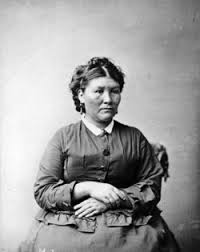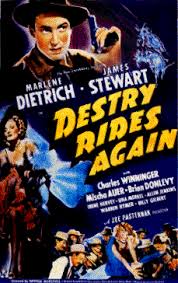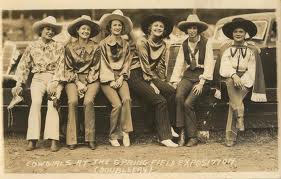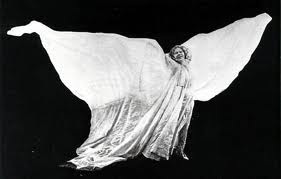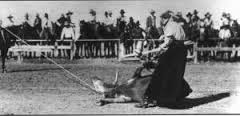1867-General William Tecumseh Sherman starts a plan to drive Indians out of the path of the transcontinental railroad.
Champion of the Seventh
Enter to win. This month enter to win a copy of
She Wore a Yellow Ribbon:
Women Soldiers and Patriots of the Western Frontier.
It was almost two in the morning and Elizabeth Custer, the young wife of the famed “boy general” George, couldn’t sleep. The heat kept her awake-a sweltering intense heat that had overtaken fort Lincoln in the Dakota Territory earlier that day. Even if the conditions had been more congenial, however, sleep would have eluded Elizabeth. The rumor that had swept through the army post around lunchtime disturbed her greatly, and until this rumor was confirmed she doubted that she’d be able to get a moment’s rest.
Elizabeth, or Libbie, as her husband and friends called her, carried her petite, slender frame over to the window and gazed out at the night sky. It had been more than two weeks since she had said good-bye to her husband. She left him and his battalion a few miles outside the fort. George had orders from his superior officers in Washington, D.C., to “round up the hostile Indians in the territory and bring about stability in the hills of Montana.”
George and Elizabeth made their good-byes and she headed back to the fort. As she rode away, she turned around for one last glance at General Custer’s column departing in the opposite direction. It was a splendid picture. The flags and pennons were flying, the men were waving, and even the horses seemed to be arching themselves to show how fine and fit they were. George rode to the top of the promontory and turned around, stood up in his stirrups, and waved his hat. They all started forward again and in a few seconds disappeared; horses, flags, men, and ammunition-all on their way to the Little Bighorn River. The was the last time Elizabeth saw her husband alive.
To learn more about Elizabeth Custer and other women soldiers and patriots of the Western Frontier read She Wore A Yellow Ribbon.
This Day…
The Woman Chief
Enter to win. This month enter to win a copy of
She Wore a Yellow Ribbon:
Women Soldiers and Patriots of the Western Frontier.
A lone Native American woman cautiously led her chestnut mare through the bluffs around Klamath Lake, an inland sea 20 miles north of the line dividing California and Oregon. The rider was Mrs. Frank “Tobey” Riddle. She belonged to the Modoc tribe that settled in the area; they called her Winema. She was known among her family and friends as one who possessed great courage and could not be intimidated by danger. She pressed on past the jagged rocks lining the transparent water, praying to the great god Ka-moo-kum-chux to give her abundant courage in the face of the certain danger that she was about to encounter.
Winema was a mediator between the Modoc people, other Indian tribes in the area, and the U. S. Army. With her skills she was able to negotiate treaties that kept the land of her ancestors in peace. Whenever that peace was threatened, her job was to set things straight. She was on her way to do just that-riding into hostile Modoc territory to persuade the chief to surrender to the cavalry.
To learn more about Winema and other women soldiers and patriots of the Western Frontier read
She Wore A Yellow Ribbon.
Tall in the Saddle
“A gun is as good or as bad as the man using it,” says Alan Ladd as the mysterious buckskin-clad stranger in Shane. “There’s some things a man just can’t run away from,” drawls a young John Wayne to his terrified fellow passengers in John Ford’s Stagecoach. “Draw fast and aim slow,” quips Richard Dix as Wyatt Earp in Tombstone.
The West and the western are the stuff of legend-and American movies. Since the birth of motion pictures more than 8,000 western films have been made. That’s a lot of cowboys, cattle, wagon trains, and shoot-outs. With the exception of Key Largo, most of my favorite films are westerns. Westerns have not only influenced the way people think, they have also influenced the way we dress and the way we talk. The following are a few of the frank, funny, poignant lines from some of those films that remind us of that independent western spirit.
From the movie The Alamo-1960
“You never pray, do you, Davy?”
“I never found the time.” Parson (Hank Worden) and Davy Crockett (John Wayne)
“I’m a stranger ‘round these here parts. What do you Texans use for drinking whiskey?”
“Drinking whiskey.”
Captain Almeron Dickson (Ken Curtis) and Beekeeper (Chill Wills)
From the movie Bad Day at Black Rock-1955
“I’ll only be here twenty-four hours.”
“In a place like this, that could be a lifetime.”
Passenger John J. McReedy (Spencer Tracy) and train conductor (bit player)
From the movie Destry Rides Again-1939
“You’d better mind your own business or you’re heading for trouble.”
“Trouble is my business.”
Saloon singer Frenchie (Marlene Dietrich) and Sheriff Tom Destry (James Stewart)
“Wait a minute, lady!”
“Who you calling a lady?!”
Sheriff Tom Destry (James Stewart) and saloon singer Frenchie (Marlene Dietrich)
Long live the western.
Cody’s Cowgirls
Congratulations to Debbie Clark! Debbie won a copy of
Buffalo Gals: Women of Buffalo Bill’s Wild West Show.
There will be another opportunity to win a book about
women of the Old West next week.
One final note about Buffalo Bill’s Wild West Show.
William Cody first brought the action and adventure of the untamed frontier to United States audiences in 1872. Wearing his trademark massive sombrero and fringed hunting suit of buckskin, Cody introduced the world to a cast of legendary western heroes. Among the talent that graced the program’s bill were Wild Bill Hickok, Pawnee Bill, and Sitting Bull. From the start the Wild West Show was a huge success. Thirty-nine years after Cody decided to embark on the risky business venture, he had amassed a fortune worth more than $3 million.
A big part of the show’s success was the showcasing of female performers. Women riders and shooters were included not just for the crowd’s amusement but also because Buffalo Bill believed women shouldn’t be left out.
To learn more about Buffalo Bill Cody and the women who performed with him read Buffalo Gals: Women of Buffalo Bill’s Wild West Show.
This Day…
The Goddess of Light
Today is the day! Enter now to win a copy of
Buffalo Gals: Women of Buffalo Bill’s Wild West Show.
Dancer Loie Fuller stepped onto the Olympic Theatre stage in Chicago and slowly walked toward Buffalo Bill Cody. He was an imposing figure dressed in buckskin. His personality so filled the auditorium that the nineteen-year-old Loie was somewhat intimidated to approach him. Cody turned his handsome face to her, flashed a pleasant smile, and introduced himself. From that moment she was at ease. After welcoming her to the cast of his Wild West program, he escorted her to the wings of the stage and handed her a script.
The year was 1881, and this was the first real performing job the teenager had been given since beginning her theatrical career in 1866. Thrilled with the opportunity to work with the famous frontier scout and war veteran, she found she was too star struck at the onset to review her lines. Loie’s association with Cody would span more than three decades.
“Throughout that time,” she admitted in her journal, “I never lost my fascination for the showman.”
To learn more about Loie Fuller and the other women who performed with Cody read Buffalo Gals: Women of Buffalo Bill’s Wild West Show.
More Tales Behind the Tombstones
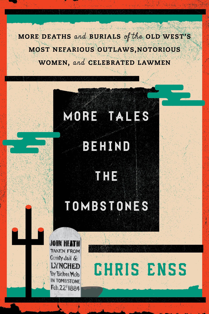
More Tales Behind the Tombstones tells the stories behind the deaths (or supposed deaths) and burials of even more of the Old West’s most nefarious outlaws, notorious women, and celebrated lawmen. Readers will learn the stories behind these legendary characters and visit the sites of tombs long forgotten while legends have lived on.Read about the lives (and deaths) of fearless, famous lawmen such as Bass Reeves, Chalk Beeson, Bill Tilghman, and Pat Garrett; learn about the dauntless women who blazed new paths for their sex in medicine, journalism, entertainment, and voting rights; and discover the intriguing facts and myths that continue to circulate about these and other infamous characters long after their grave markers have become worn down or simply lost to time.
The Cowboy Cowgirl
Enter to win! Here’s where you enter for a chance to win a copy of
Buffalo Gals: Women of Buffalo Bill’s Wild West Show.
A frayed lasso dropped over the neck of an angry steer and the cowgirl on the other end jerked it tight. The rope snapped in two, and the animal raced off to join the other equally agitated steer.
Eighteen-year-old Lucille Mulhall studied the wild herd, grabbed a rope, and spurred her horse forward. Setting her sights on another steer, she twirled her rope over her head and threw it out. The lasso fell over one of the animal’s horns. Lucille quickly jerked the rope loose and tossed it out again. This time the throw was true. Her horse stopped quickly and the steer was jerked on its back. Lucille jumped off her ride and quickly tied the feet of the animal together. Forty-five seconds had passed since the steer had been roped and then tied. Lucille Mulhall, the petite teenager from Oklahoma, had set a steer-roping record at yet another country fair.
It was the spring of 1903, and before the year ended the well-known female conqueror of beef and horn had broken every existing record set by her male counterparts. Famous humorist and writer Will Rogers watched the graceful, fearless roper and rider from his seat in the rodeo stands in Oklahoma City. He was a fan of Lucille’s. Among some of her other fans were President Theodore Roosevelt, Tom Mix, and Buffalo Bill Cody.
To learn more about Lucille Mulhall and the other women who performed with Cody read Buffalo Gals: Women of Buffalo Bill’s Wild West Show.


